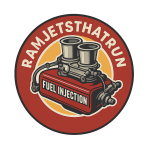I’m often asked if a Rochester injection system will work properly on a highly modified small block. The key to the answer is the camshaft used. That’s because a Rochester FI system uses engine rpm, plenum manifold vacuum, and air meter venturi vacuum levels to determine how much gas to squirt from the nozzles. The injection unit doesn’t know what displacement engine is sitting under it. The injection doesn’t really care about the compression ratio either. However, the unit does know and care how hard the engine is sucking on the manifold runners at all running speeds. And, the engine vacuum / rpm curve is primarily determined by the profile of the cam lobes.
It’s possible to redesign the axle link, spill valve, enrichment lever, and idle vacuum signal systems to work with a very radical aftermarket camshaft. Well, at least it’s possible in theory. It’s certainly not practical though, and I’m not about to attempt to do it for a customer. It makes much more sense to me to confine engine modifications to installing better flowing cylinder heads and a using a larger displacement block. I would definitely install a mild camshaft with a near-stock profile if I was going to use Rochester fuel injection. By mild, I mean a cam that produces at least a steady 12 inches of mercury vacuum in the plenum at an 850 rpm idle speed.
Chevrolet used two different high performance camshafts with Rochester fuel injection on the assembly line. The first of these cams, used in ’57 through ’61 283 engines, was the “Duntov” or “097” solid lifter design. This same cam was also used in the ’62 – ’63 327 fuel injected Corvette engines. I know through my own testing that the 097 cam will produce 13 to 14 inches of vacuum at an 800 rpm idle IF the lash is set at .012″ on the intake and .018″ on the exhaust valves.
Chevrolet used a much more radical cam in the ’64 – ’65 327 fuel injected engines. This cam is known as the “30-30″ or 375hp solid lifter cam. This cam usually produces about 12 inches of steady vacuum at 850 rpm if the lash is set at .030″ and .030”. I say “usually” because some modern aftermarket versions of this cam require more lash than .030/.030″ to reach this level of vacuum. Some brands need as much as.035″ lash on both intake and exhaust valves to make acceptable vacuum at low engine speeds.
These two cams aren’t the only grinds that will work with Rochester FI. The old 327/350hp hydraulic cam will work just fine too. So will the 1970 – ’72 LT-1 solid lifter cam. There are probably many more acceptable cams that I haven’t ever tried. Just remember to check the plenum (manifold) vacuum level at an 850 rpm idle speed to determine if your cam is making enough vacuum to use Rochester injection. If you come up with less than 12 inches, then you’re going to have a drivability problem that will be extremely hard to ignore around town. Out on the freeway it won’t make a significant difference in driving sensation. So, if you insisted on using a radical cam in an injected engine, I guess you could just keep the revs over 3,000 all the time. Yeah…..now THAT’S the ticket for a relaxing cruise around town!
